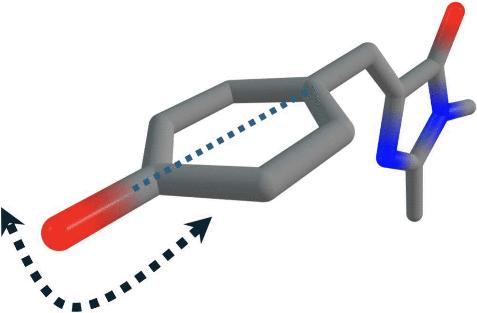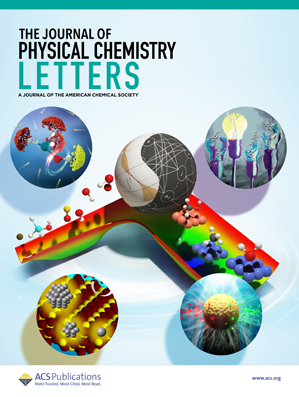Temperature Controlled Decay and Pendulum Dynamics of Green Fluorescent Protein (GFP) Chromophore
IF 4.8
2区 化学
Q2 CHEMISTRY, PHYSICAL
引用次数: 0
Abstract
The excited-state dynamics of the GFP chromophore, HBDI– (anionic p-hydroxybenzylidene-2,3-dimethylimidazolinone), were investigated through a combination of theoretical nonadiabatic molecular dynamics (NAMD) simulations and femtosecond transient absorption spectroscopy (fs-TA). The NAMD simulations revealed that the primary dynamics in excited states involve the formation of a P-twisted intermediate (S1min,P), which undergoes pendulum-like oscillations with respect to ϕ = 90°. This motion serves as a reservoir for the excited-state population and the primary source of fluorescence. Rather than a direct channel from the major S1min,P, a coordinated pathway of S1min,P → S1min → S1min,I → S0 is responsible for the decay to the ground state, emphasizing the importance of planar intermediate (S1min) formation. The experimental fs-TA spectra confirmed these dynamics, revealing three distinct time scales (340–470 fs, 1.4 ps, and 8.3 ps), corresponding to the formation of S1min,P and its decay governed by the coordinated pathway. At low temperatures, the coordinated decay pathway is suppressed, leading to prolonged fluorescence lifetimes, consistent with low-temperature experimental results. This study presents a new model for the excited-state dynamics of GFP chromophore, suggesting that pendulum motion and the coordinated decay pathway play a crucial role in regulating fluorescence intensity.

绿色荧光蛋白(GFP)发色团的温控衰减和钟摆动力学
通过结合非绝热分子动力学(NAMD)理论模拟和飞秒瞬态吸收光谱(fs-TA),研究了 GFP 发色团 HBDI-(阴离子对羟基苯亚甲基-2,3-二甲基咪唑啉酮)的激发态动力学。NAMD 模拟显示,激发态的主要动力学过程涉及 P 扭曲中间体(S1min,P)的形成,该中间体相对于 ϕ = 90° 发生钟摆式振荡。这种运动是激发态种群的储存库,也是荧光的主要来源。在衰减到基态的过程中,S1min,P → S1min → S1min,I → S0 是一个协调的路径,而不是从主要的 S1min,P 直接进入基态,这强调了平面中间体(S1min)形成的重要性。实验fs-TA光谱证实了这些动力学,揭示了三个不同的时间尺度(340-470 fs、1.4 ps和8.3 ps),分别对应于S1min,P的形成及其受协同途径支配的衰变。在低温条件下,协同衰变途径受到抑制,导致荧光寿命延长,这与低温实验结果一致。这项研究为 GFP 发色团的激发态动力学提出了一个新的模型,表明钟摆运动和协调衰变途径在调节荧光强度中起着至关重要的作用。
本文章由计算机程序翻译,如有差异,请以英文原文为准。
求助全文
约1分钟内获得全文
求助全文
来源期刊

The Journal of Physical Chemistry Letters
CHEMISTRY, PHYSICAL-NANOSCIENCE & NANOTECHNOLOGY
CiteScore
9.60
自引率
7.00%
发文量
1519
审稿时长
1.6 months
期刊介绍:
The Journal of Physical Chemistry (JPC) Letters is devoted to reporting new and original experimental and theoretical basic research of interest to physical chemists, biophysical chemists, chemical physicists, physicists, material scientists, and engineers. An important criterion for acceptance is that the paper reports a significant scientific advance and/or physical insight such that rapid publication is essential. Two issues of JPC Letters are published each month.
 求助内容:
求助内容: 应助结果提醒方式:
应助结果提醒方式:


